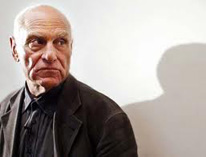|
Richard Serra
Richard Serra (born November 2, 1939) is an American minimalist sculptor and video artist known for working with large-scale assemblies of sheet metal. Serra was involved in the Process Art Movement.
Serra was born in San Francisco and he went on to study English literature at the University of California, Berkeley and later at the University of California, Santa Barbara between 1957 and 1961. While at Santa Barbara, he studied art with Howard Warshaw and Rico Lebrun. On the West Coast, he helped support himself by working in steel mills, which was to have a strong influence on his later work.
After studying painting with Josef Albers at the Yale University School of Art and Architecture between 1961 and 1964, Serra continued his training abroad, spending a year each in Florence and Paris. In 1964, he was awarded a Fulbright Scholarship for Rome. Since then, he has lived in New York, where he first used rubber in 1966 and began applying his characteristic work material lead in 1968. In New York, his circle of friends included Carl Andre, Walter De Maria, Eva Hesse, Sol LeWitt, and Robert Smithson.
He is the brother of famed San Francisco trial attorney Tony Serra. Serra lives outside of New York and in Nova Scotia.
In 1966, Serra made his first sculptures out of nontraditional materials such as fiberglass and rubber. Serra's earliest work was abstract and process-based made from molten lead hurled in large splashes against the wall of a studio or exhibition space. Still, he is better known for his minimalist constructions from large rolls and sheets of metal (COR-TEN-Steel). Many of these pieces are self-supporting and emphasize the weight and nature of the materials. Rolls of lead are designed to sag over time. His exterior steel sculptures go through an initial oxidation process, but after 8-10 years, the patina of the steel settles to one color that will remain relatively stable over the piece's life. Serra often constructs site-specific installations, frequently on a scale that dwarfs the observer.
In 1981, Serra installed Tilted Arc, a gently curved, 3.5 meter high arc of rusting mild steel in the Federal Plaza in New York City. There was controversy over the installation from day one, largely from workers in the buildings surrounding the plaza who complained that the steel wall obstructed passage through the plaza. A public hearing in 1985 voted that the work should be moved, but Serra argued the sculpture was site specific and could not be placed anywhere else. Serra famously issued an often-quoted statement regarding the nature of site-specific art when he said, "To remove the work is to destroy it." Eventually on 15 March 1989, the sculpture was dismantled by federal workers and taken for scrap. William Gaddis satirized these events in his biting 1994 novel A Frolic of His Own.
In 2002, a similar installation titled Vectors was to be built at the California Institute of Technology from the bequest of Eli Broad. The piece, to be four steel plates of similar material as Tilted Arc zig-zagging across one of the few green spaces at the university, met significant opposition by the student body and professors as being a "derivative" rehash of earlier works, or an 'arrogant' piece that [belied] Institute values." The piece was never installed.
Another famous work of Serra's is the mammoth sculpture Snake, a trio of sinuous steel sheets creating a curving path, permanently located in the largest gallery of the Guggenheim Museum Bilbao. In 2005, the museum mounted an exhibition of more of Serra's work, incorporating Snake into a collection entitled The Matter of Time. The whole work consists of eight sculptures measuring between 12 and 14 feet in height and weighing from 44 to 276 tons.
He has not always fared so well in Spain, however; also in 2005, the Centro de Arte Reina Sofia in Madrid announced that a 38-tonne sculpture of his had been "mislaid". In a recent development, a duplicate copy is going to be made and displayed in Madrid.
In spring 2005, Serra returned to San Francisco to install his first public work in that city (previous negotiations for a commission fell through) - two 50-foot steel blades in the main open space of the new University of California, San Francisco (UCSF) campus. Weighing 160 tons, placing the work in its Mission Bay location posed serious challenges, since it is, like many parts of San Francisco, built on landfill. In 2000 he installed 'Charlie Brown,' a 60-foot-tall sculpture in the new Gap Inc. headquarters in San Francisco. To encourage oxidation, or rust, sprinklers were initially directed toward the four German-made slabs of steel that make up the work (see External links).
In the summer of 2007 the Museum of Modern Art presented a retrospective of Serra's work in New York. Intersection II (1992-1993) and Torqued Ellipse IV (1998) were included in this show along with three new works. The retrospective consisted of 27 of Serra's works, including three large new sculptures made specifically for the second floor of the museum, two works in the garden, and earlier pieces from the 1960s through the 1980s.
A retrospective is an occasion to reflect and take stock, but it's double edged in that it puts me into a nostalgic relationship to my own history, which I'd rather not dwell upon. The rearview mirror perspective is not one that I'd take if there wasn't a retrospective pending. I would rather think about the work that I am doing and the work that's in front of me to do and not have to look over my shoulder. It's obvious to me that I am not the same person that I was 40 years ago, nor are the issues that I am concerned with the same. A retrospective might give the impression of a seamless linearity of development, but my work does not evolve that way. It evolves in fits and starts. Oftentimes, the solution to a problem leads to an altogether different idea.
Work similar to that of his in the Netherlands (pictured) can be found in Storm King Art Center in Upstate New York.
From May 7 to June 15, 2008 Richard Serra showed his installation "Promenade" at the Grand Palais, Paris. "A radical, poetic landscape of steel, minimalist yet full of movement." Serra was the second artist, after Anselm Kiefer, who was invited to fill the 13,500 m nave of the Grand Palais with a group of new works created specially for the event.
Birmingham City Council is currently considering a proposal for an outdoor installation by Richard Serra in front of their new Library of Birmingham to replace the destroyed "Forward" sculpture by Raymond Mason in Centenary Square.
In December 2008, after almost 20 years in storage, his steel sculpture "Slat" was re-anchored in La Defense, the Parisian business district. The sculpture spent five years in a nearby Paris suburb, Puteaux, but in 1989 vandalism and graffiti prompted that town's mayor to remove it. "Slat" has five 25-ton steel plates that lean on one another to form a tall, angular tepee. because of its weight, officials chose to ground it in a traffic island behind the Grande Arche.
Serra was one of the four performers in the premiere of the Steve Reich piece Pendulum Music on May 27, 1969 at the Whitney Museum of American Art. The other performers were Michael Snow, James Tenney and Bruce Nauman.
Hand Catching Lead (1968) was Serra's first film and features a single shot of a hand in an attempt to repeatedly catch chunks of material dropped from the top of the frame. In Boomerang (1974), Serra taped Nancy Holt as she talks and hears her words played back to her after they have been delayed electronically.
Serra has made a number of films concerning the manufacture and use of his favorite material, steel. Steelworks is shot inside a German steelworks and includes an interview with a steelworker, while Railroad Turnbridge is a series of shots taken on the Burlington and Northern bridge over the Willamette River near Portland, Oregon, as it opens to let a ship pass. These films can be viewed in a room off the Arcelor gallery in the Guggenheim museum in Bilbao.
He also produced the classic 1973 short film "Television Delivers People", a critique of the corporate mass media with elevator music as the soundtrack.
Serra appears in Matthew Barney's 2002 film Cremaster 3 as Hiram Abiff ("the architect"), and later as himself in the climactic The Order section - the only part of a Cremaster film commercially available on DVD.
Since 1971, Serra has focused not only on sculptural works, but also onlarge-scale drawings on paper using various techniques. His drawing material is the paintstick, a wax-like grease crayon. Serra melts several paintsticks to form large pigment blocks. Major presentations of Serra's graphic oeuvre include exhibitions at the Bonnefantenmuseum, Maastricht, in 1990; at Serpentine Gallery, London, in 1992; and at Kunsthaus Bregenz, Bregenz, in 2008.
At the 2006 Whitney Biennial, Serra showed a simple litho crayon drawing of an Abu Ghraib prisoner with the caption "STOP BUSH." This image was later used by the Whitney Museum to make posters for the Biennial. The posters featured an altered version of the text that read "STOP B S ." Serra also created a variation on Goya's Saturn Devouring His Son featuring George W. Bush's head in place of Saturn's. This was featured prominently in an ad for the website pleasevote.com (now defunct) on the back cover of the July 5, 2004 issue of The Nation.
Colby College recently acquired 150 works on paper by Serra, making it the second largest collection of Serra's work outside of the Museum of Modern Art in New York.
The drone band Sunn O))) used "Out-of-Round X" (1999) as the cover of their seventh studio album released in 2009, called Monoliths & Dimensions.
His work was featured on BBC One in "Imagine...Richard Serra: Man of Steel" on Tuesday 25 November 2008 which described him as "Sculptor and giant of modern art Richard Serra discusses his extraordinary life and work. A creator of enormous, immediately identifiable steel sculptures that both terrify and mesmerise, Serra believes that each viewer creates the sculpture for themselves by being within it." Contributors include Chuck Close, Philip Glass and Glenn D Lowry, Director of MoMA. He was interviewed at length by the BBC's Alan Yentob.
Serra was awarded the honorary degree of Doctor of Fine Arts by Williams College in 2008 and by Harvard University in 2010. In 1994, he was honored with the Praemium Imperiale.
Courtesy Wikipedia |


